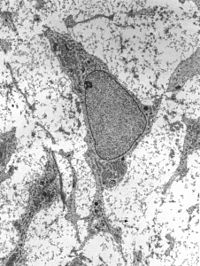Mesenchymal tumors
| Mesenchyme | |
|---|---|

Transmission electron micrograph of mesenchyme displaying the ultrastructure of a typical cell and matrix.
|
|

Mesenchyme (pointer) stained with H&E
|
|
| Details | |
| Carnegie stage | 6b |
| Precursor | Primarily mesoderm |
| Identifiers | |
| Code | TE E5.16.4.0.3.0.18 |
|
Anatomical terminology
[]
|
|
Mesenchyme, also known as mucous connective tissue or mucoid connective tissue, is a type of connective tissue found mostly during development of the embryo. It is composed mainly of ground substance with few cells or fibers. It can also be referred to as a group of mucoproteins found in certain types of cysts (etc.), resembling mucus. It is most easily found as a component of Wharton's jelly.
Mucous connective tissue forms the umbilical cord.
The vitreous of the eyeball is a similar tissue.
The mesenchyme originates from the mesoderm. From the mesoderm, the mesenchyme appears as an embryologically primitive "soup". This "soup" exists as a combination of the mesenchymal cells plus serous fluid plus the many different tissue proteins. Serous fluid is typically stocked with the many serous elements, such as sodium and chloride. The proteins are produced by the DNA of the mesenchymal cells. Which proteins are created depend upon how the mesenchyme differentiates. For example two proteins, as connective tissue develops, are the muscle fiber proteins, actin and myosin. These mesenchymal components will in turn give rise to mesenchymal products. Specifically, the mesenchyme develops into the tissues of the lymphatic and circulatory systems, as well as the musculoskeletal system. This latter system is characterized as connective tissues throughout the body, such as bone, muscle and cartilage. A malignant cancer of mesenchymal cells is a type of sarcoma.
Mesenchyme is characterized morphologically by a prominent ground substance matrix containing a loose aggregate of reticular fibrils and unspecialized cells. Mesenchymal cells can migrate easily, in contrast to epithelial cells, which lack mobility and are organized into closely adherent sheets, and are polarized in an apical-basal orientation.
...
Wikipedia
